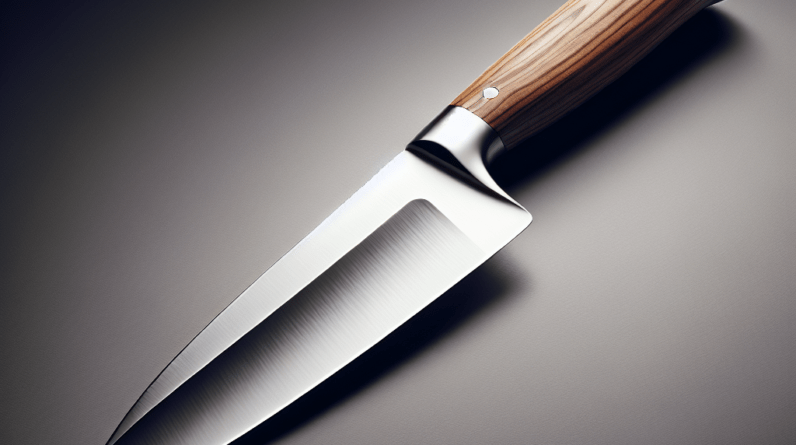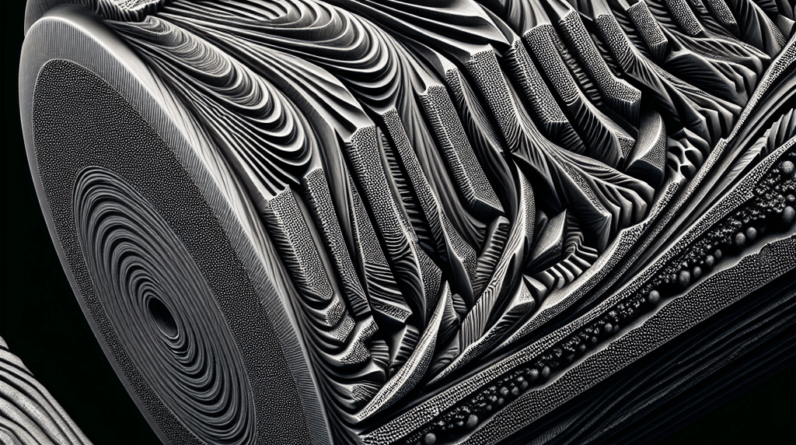Properly storing sharp knives can make all the difference in keeping them sharp, safe, and reliable for years to come. Whether you’re an amateur chef or a seasoned pro, understanding the correct way to store your knives is essential. In this article, we’ll explore various methods, techniques, and options to help you preserve the longevity and functionality of your knives while ensuring a clutter-free and organized kitchen space. So, let’s dive into the world of knife storage and discover the secrets to keeping your blades in tip-top shape!

Choosing a proper storage location
When it comes to storing sharp knives, choosing the right storage location is crucial. Not only does it ensure the safety of anyone who may come into contact with the knives, but it also helps to maintain the quality and sharpness of the blades over time. Here are some factors to consider when selecting a storage location for your knives:
Consider the environment
The environment in which you store your knives plays a significant role in their longevity. It’s best to choose a storage location that has a controlled temperature and humidity level. Extreme temperature fluctuations and high levels of humidity can cause your knives to corrode and become dull more quickly. Avoid storing your knives in areas like the basement or near the stove, where humidity levels may be higher.
Avoid damp areas
Moisture is the enemy of sharp knives. It can lead to rust and corrosion, which not only affects the appearance of the blades but also compromises their performance. Be sure to avoid storing your knives in damp areas like the sink or dishwasher. Instead, opt for a dry location where moisture levels are low, such as a kitchen cabinet or a dedicated knife drawer.
Keep away from direct sunlight
Exposing your knives to direct sunlight can have detrimental effects on their quality. The ultraviolet (UV) rays from the sun can cause the handles to fade and become brittle, while affecting the sharpness and integrity of the blades. To protect your knives from sunlight damage, choose a storage location away from windows or invest in a knife block or sheath that provides UV protection.
Using knife blocks or knife racks
Knife blocks and knife racks are popular storage options for their convenience and accessibility. Here are three common types of knife blocks and racks to consider:
Knife block with slots
A knife block with slots is a classic and practical way to store your knives. The block typically comes with various-sized slots to accommodate different types of knives, from chef’s knives to paring knives. This type of storage allows you to keep your knives within reach while keeping them safely organized and protected from damage.
Magnetic knife rack
For those who prefer a more modern and space-saving option, a magnetic knife rack can be a great choice. These racks use powerful magnets to hold the knives securely in place, eliminating the need for slots. Magnetic knife racks offer excellent visibility of your knives, making it easy to select the one you need quickly. However, it’s essential to ensure that the magnets are strong enough to hold the knives securely.
In-drawer knife block
If you prefer to keep your knives tucked away and out of sight, an in-drawer knife block may be the perfect solution. These blocks are designed to fit inside a standard kitchen drawer, offering a clutter-free countertop while keeping your knives organized and protected. In-drawer knife blocks often come with slots or individual compartments to securely hold each knife in place.
Using knife sheaths or blade guards
Knife sheaths and blade guards are another practical way to store your sharp knives, especially if you have limited counter space or prefer to keep your knives concealed. Here are some options to consider:
Individual blade guards
Individual blade guards are the most common type of knife protection. These guards are usually made of plastic or other materials that cover the blade entirely, ensuring safety and maintaining sharpness. They are particularly useful when storing knives in a drawer, preventing accidental cuts and scratches.
Magnetic sheaths
For those who appreciate the convenience of magnetic storage but still want the added protection of sheaths, magnetic sheaths are an excellent choice. These sheaths combine the security of blade guards with the convenience of magnetic storage, allowing you to easily attach and detach the sheaths from a magnetic surface.
Knife rolls or cases
Knife rolls and cases are ideal for those who frequently travel with their knives or want a portable storage solution. These compact and durable options provide individual compartments for each knife, typically secured with a zipper or straps. Knife rolls and cases are not only great for storage but also offer protection during transportation.
Implementing proper knife care practices
Proper knife care practices are essential for maintaining the sharpness and performance of your knives. Here are some key practices to incorporate into your knife storage routine:
Clean and dry knives before storage
Before placing your knives in their designated storage location, it’s crucial to clean and thoroughly dry them. Residual moisture can promote rust and corrosion, leading to a decline in blade quality. Make it a habit to hand wash your knives with mild detergent and warm water, then immediately dry them using a clean towel or dishcloth.
Avoid storing knives loose in a drawer
Storing knives loose in a drawer can be a recipe for disaster. The blades may come into contact with other utensils, causing unintentional damage and increasing the risk of accidents when retrieving them. To prevent blade-to-blade contact and keep your knives organized, consider using blade guards or a dedicated knife block or rack mentioned earlier.
Regularly inspect and sharpen knives
Regularly inspecting your knives is an essential step in knife care. Look out for any signs of wear, such as chipped or dull blades, loose handles, or rust spots. If you notice any issues, it’s crucial to address them promptly to maintain the quality and safety of your knives. Sharpening your knives regularly using a sharpening stone or honing rod will help keep them in optimal condition.

Ensuring safety and accessibility
When it comes to storing sharp knives, safety should be a top priority. Additionally, having easy access to your knives can enhance your cooking experience. Here are some tips to ensure safety and accessibility:
Protecting children and pets
If you have children or pets in your home, it’s essential to take extra precautions when storing your knives. Choose a storage location that is inaccessible to little hands and curious animals. Opt for high cabinets or knife blocks positioned out of their reach. To further enhance safety, consider using locked drawers or cabinets specifically designed to prevent accidental access.
Avoid overcrowding the storage space
Overcrowding your knife storage area can increase the risk of accidental cuts when trying to retrieve a knife. It can also cause unnecessary wear and tear on the blades. Ensure that your storage option provides ample space for your knives, allowing them to sit comfortably without touching each other. This not only promotes safety but also helps preserve the sharpness and overall quality of the blades.
Organize knives for easy retrieval
Efficiency in the kitchen starts with easy access to your tools. Organize your knives in a way that allows you to quickly identify and retrieve the one you need. Whether it’s using a knife block with labeled slots or arranging your knives based on blade type and size, finding an organization system that works for you will save time and enhance your cooking experience.
Considering alternative storage options
While knife blocks and sheaths are popular choices for knife storage, there are several alternative options worth considering. Here are a few:
Knife blocks with built-in sharpeners
If convenience is a top priority, you may want to explore knife blocks that come with built-in sharpeners. These blocks provide a space-saving storage solution while also allowing you to maintain your knives’ sharpness easily. The built-in sharpeners ensure that your knives are always ready for use, eliminating the need for separate sharpening tools.
Magnetic strips on the wall
For those who want to save precious counter space, magnetic strips mounted on the wall can be a stylish and functional option. These strips securely hold the knives in place, resulting in a sleek and modern storage solution. However, be cautious with the placement of the magnetic strip to ensure it is not within the reach of children or pets.
Knife storage bags or rolls
If you are on the go or have limited storage space in your kitchen, knife storage bags or rolls might be the ideal solution. These compact and portable options provide individual pockets or compartments for your knives, making them easy to carry and protect during travel. Knife storage bags or rolls also come in various sizes to accommodate different knife sets.

Tips for specific knife types
Different types of knives require specific care and storage considerations. Here are some tips for storing specific knife types:
Storing chef knives
Chef knives are among the most commonly used and versatile knives in the kitchen. To properly store chef knives, consider using a knife block with large slots that can accommodate their wide blades. Alternatively, a knife roll or case with individual compartments can provide excellent protection while allowing for easy transportation.
Storing steak knives
Steak knives are often used for special occasions or dining experiences. To maintain their sharpness and quality, store steak knives in a knife block or sheaths specifically designed for these types of blades. The storage option should provide individual slots or compartments to avoid blade-to-blade contact and prevent accidental cuts when retrieving them.
Storing serrated knives
Serrated knives, such as bread knives or serrated utility knives, require special care due to their unique blade design. To prevent dulling and maintain the serrations’ effectiveness, store these knives separately from other blades. Consider using blade guards or individual compartments to keep the serrated edges protected and ensure their longevity.
Traveling with sharp knives
If you need to travel with your sharp knives, it’s essential to take the necessary precautions to prevent accidents and protect the blades. Here are some tips for traveling with sharp knives:
Use a secure knife case
Invest in a reliable and secure knife case specifically designed for travel. These cases typically come with individual compartments to hold each knife safely in place, preventing accidental contact. Look for a case with a sturdy exterior and secure closures to ensure the knives remain protected during transit.
Follow airline regulations
If you plan to bring your knives on a plane, familiarize yourself with the airline’s regulations regarding sharp objects. Different airlines have different rules and restrictions, so it’s important to review these guidelines before packing your knives. In many cases, knives with blades longer than a certain length must be checked in with your luggage.
Protect knife blades during transit
To protect the blades from damage during transit, consider placing blade guards or sheaths on each knife. This additional layer of protection can prevent accidental cuts when retrieving the knives from your luggage and eliminate the risk of blades coming into contact with other items.
Additional precautions and considerations
When it comes to storing sharp knives, there are additional precautions and considerations to keep in mind:
Avoid storing knives near other utensils
To prevent accidental damage to your knives or other utensils, it’s best to store them separately. Blade-to-blade contact can lead to chips or dulling of the knife blades. Additionally, sharp knives can cause harm if someone reaches into a drawer without being aware of their presence. Storing knives in dedicated storage options, such as blocks or racks, will help mitigate these risks.
Protect knife handles from damage
While much attention is often given to protecting the blades, it’s equally important to safeguard the handles of your knives. Constant banging or rubbing against other objects can cause handles to become loose or damaged over time. To prevent this, ensure that your storage option keeps the handles securely in place and minimizes any unnecessary contact that could lead to wear and tear.
Consider knife storage options in small kitchens
If you have a small kitchen with limited counter or storage space, choosing the right knife storage option is even more critical. Look for space-saving solutions such as in-drawer knife blocks or magnetic strips mounted on the wall. Utilizing vertical space with wall-mounted storage options can help declutter your counter and make your knives easily accessible.
Benefits of proper knife storage
Implementing proper knife storage practices offers several benefits that go beyond simply keeping your knives organized. Here are some advantages of proper knife storage:
Preserve sharpness and overall knife quality
Proper knife storage helps maintain the sharpness and quality of the blades over time. By storing knives in designated slots, sheaths, or blocks, you can prevent blade-to-blade contact and avoid unnecessary wear and tear. Additionally, protecting your knives from moisture, humidity, and sunlight ensures they stay in prime condition for longer.
Reduce the risk of accidents
Storing your knives safely reduces the risk of accidents, both for yourself and others in your household. By using blade guards, knife blocks, or other storage options, you can prevent accidental cuts when retrieving knives from drawers or cabinets. Keeping knives out of reach from children and pets further minimizes the chances of any unfortunate incidents.
Prolong the lifespan of knives
Proper storage practices help prolong the lifespan of your knives, saving you money in the long run. By protecting the blades from damage and maintaining their sharpness, you can avoid the need for frequent replacements or professional sharpening. Well-cared-for knives can last for many years, providing you with reliable tools for your culinary endeavors.
In conclusion, choosing the correct way to store sharp knives is essential for maintaining their quality, performance, and safety. Consider factors such as the environment, avoiding damp areas, and keeping knives away from direct sunlight. Utilize knife blocks, racks, sheaths, or blade guards to ensure secure storage options. Implementing proper knife care practices, ensuring safety and accessibility, and considering alternative storage options are key steps in maintaining your knives. Remember to store knives separately, protect handles, and think about storage solutions in small kitchens. By following these guidelines, you can preserve the sharpness, reduce the risk of accidents, and prolong the lifespan of your beloved knives.









